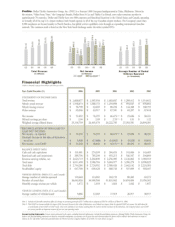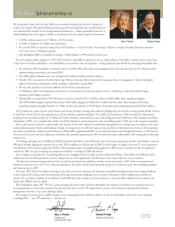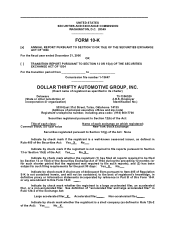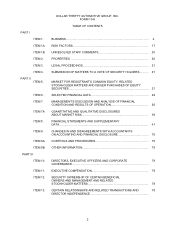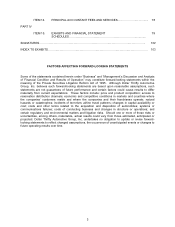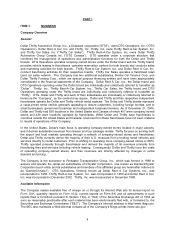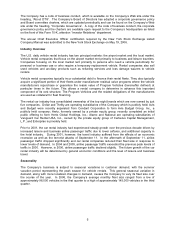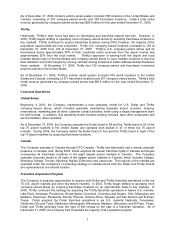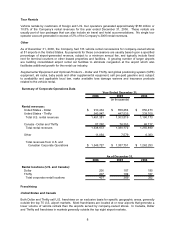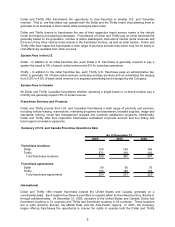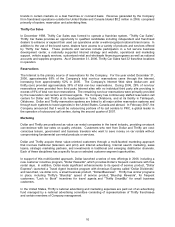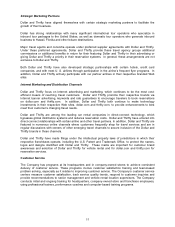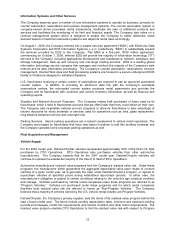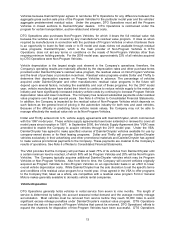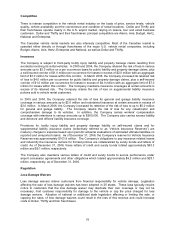Thrifty Car Rental 2006 Annual Report Download - page 11
Download and view the complete annual report
Please find page 11 of the 2006 Thrifty Car Rental annual report below. You can navigate through the pages in the report by either clicking on the pages listed below, or by using the keyword search tool below to find specific information within the annual report.The Company has a code of business conduct, which is available on the Company’s Web site under the
heading, “About DTG”. The Company’s Board of Directors has adopted a corporate governance policy
and Board committee charters, which are updated periodically and can be found on the Company’s Web
site under the heading, “Corporate Governance”. A copy of the code of business conduct, the corporate
governance policy and the charters are available upon request to the Company’s headquarters as listed
on the front of this Form 10-K, attention “Investor Relations” department.
The annual Chief Executive Officer certification required by the New York Stock Exchange Listed
Company Manual was submitted to the New York Stock Exchange on May 19, 2006.
Industry Overview
The U.S. daily vehicle rental industry has two principal markets: the airport market and the local market.
Vehicle rental companies that focus on the airport market rent primarily to business and leisure travelers.
Companies focusing on the local market rent primarily to persons who need a vehicle periodically for
personal or business use or who require a temporary replacement vehicle. Rental companies also sell
used vehicles and ancillary products such as refueling services and loss damage waivers to vehicle
renters.
Vehicle rental companies typically incur substantial debt to finance their rental fleets. They also typically
acquire a significant portion of their fleets under manufacturer residual value programs where the vehicle
manufacturers repurchase or guarantee the resale value of Program Vehicles (hereinafter defined) at
particular times in the future. This allows a rental company to determine in advance this important
component of its cost structure. The Program Vehicles and the related obligations of the manufacturers
are used as collateral for fleet financing.
The rental car industry has consolidated ownership of the top eight brands which are now owned by just
five companies. Dollar and Thrifty are operating subsidiaries of the Company which is publicly held; Avis
and Budget were recently separated from Cendant Corporation to form Avis Budget Group, Inc., a
publicly held company; Hertz, formerly owned by a private equity group, recently completed an initial
public offering to form Hertz Global Holdings, Inc.; Alamo and National are operating subsidiaries of
Vanguard Car Rental USA, Inc., owned by the private equity group of Cerberus Capital Management,
L.P.; and Enterprise is privately held.
Prior to 2001, the car rental industry had experienced steady growth over the previous decade driven by
increased leisure and business airline passenger traffic due to lower airfares, and additional capacity in
the hotel industry. During 2001, however, the travel industry suffered from the effects of an economic
recession as well as the terrorist attacks of September 11. In the aftermath of September 11, airline
passenger traffic dropped significantly and car rental companies reduced their fleet size in response to
lower levels of demand. In 2004 and 2005, airline passenger traffic exceeded the previous peak levels of
traffic in 2000. However, in 2006, airline passenger traffic declined slightly. The future growth of the car
rental industry will be determined by general economic conditions and the level of leisure and business
travel.
Seasonality
The Company’s business is subject to seasonal variations in customer demand, with the summer
vacation period representing the peak season for vehicle rentals. This general seasonal variation in
demand, along with more localized changes in demand, causes the Company to vary its fleet size over
the course of the year. In 2006, the Company’s average monthly fleet size ranged from a low of
approximately 96,000 vehicles in the first quarter to a high of approximately 145,000 vehicles in the third
quarter.
5



